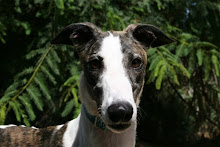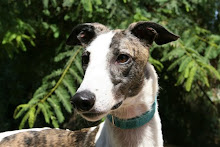Regardless of the size or breed or mix of your dog, there are potential hazards every time you leash it and take it for a walk. But most dogs really need and love walks--and walking a dog is good for a human, too.
Clearly, there are unforeseen events that cannot be avoided. But, there are some measures you can take to prevent preventable disasters.
First, look at your walking equipment. Check the fasteners. Do they actually close tightly? Do you see fraying on a collar, harness or leash? As my dogs have gotten larger, I have paid more attention to the quality of collars, harnesses and leashes. Bingley, The Survivor, has a custom made Martingale collar by Laurel Ehrenfreund. His leashes and harness are from 2houndsdesign.com Bingley needs both a collar and a harness because he was a successful racer and still thinks all furry critters need to be chased. Your large dog might be very laid back, but prepare for the unexpected. Long leashes should not be used for larger dogs. You shouldn't require a degree in physics to realize that the longer the leash, the greater the pull. I use a four foot leash on Greyhounds and shorten the leash if I see potential for concern.
Smaller dogs have, traditionally, been walked on longer leashes. But NO dog should be walked on a leash longer than six feet. EVER.
Observe and learn your dog's body language. Some dogs are obvious. If they are focusing on another dog, human or critter, their ruff will stand up and they will utter a guttural growl. But many dogs send much more subtle signals. My Wheaten, Champers' signal was a marvel of nuance. It took me several years to recognize it--just the slightest stiffening of posture. But once I recognized it, I took evasive action either by turning him around so he could not make eye contact with the other dog, or by crossing the street to put distance between him and the other dog.
If you are approaching another dog, watch for signs of arousal, particularly a "staring match" between your dog and another dog. Not. A. Good. Sign. This is not a time to worry about "sending anxious messages down the leash". This is the time to take action. Change directions. Cross the street. Tell your dog "NO!" in a firm voice. I promise you that taking the time to retrace your steps in order to avoid a confrontation will take far less time--and money-- than a emergency trip to the vet with a bleeding, traumatized dog.
If your dog shows signs of wanting to chase another dog or critter, lifting its back legs to remove its "motor" is the best intervention. But sometimes, all you have time for is to wrap a leash around its front legs or straddle the dog and hang on for dear life.
If you are walking a small dog and are approaching a large dog that you do not know for a fact is a long time friend of your dog, Pick Up Your Dog !
If you choose to allow your dog to "say hi" to another dog, face-to-face is not a dog friendly way to introduce them--not even dogs who know each other. If the other dog's human doesn't understand that fact, you might think twice about putting your dog into close proximity with the other dog. Someone who doesn't know that nose to rear is the best way for dogs to be introduced or to greet old canine friends can't be trusted to act promptly to defuse sudden hostility between dogs.
And don't tell me "My dog loves everybody." "They're old friends". Just this morning, Bingley walked with three "old friends". Old friend Hattie was having a Very Bad Day. Hattie's chronic illness had flared up, and Bingley got a growl from her instead of a sniff. But fortunately, I could trust Hattie's human to defuse Hattie while I distracted Bingley. And a happy walk was had by all.
If you are walking your dog on a retractable leash on a city or suburban street, or in a city or suburban park you are inviting Trouble. Trouble for your dog. Trouble for every dog you meet. Ultimately Trouble for You.
All of the above tips assume that your dog and the dogs you are meeting are leashed. Coping with unleashed dogs introduces a whole new level of risk. A later post will address this problem.
But obviously, I don't have all the answers to the problem of off leash dogs. If I did, Portia would still be alive, and I would not be writing this blog.
Tuesday, August 18, 2009
Subscribe to:
Post Comments (Atom)
.jpg)
.jpg)
.jpg)

No comments:
Post a Comment